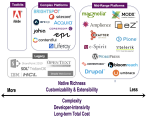Do You Really Want a Power-User Interface for Your WCM Platform?
Web CMS vendors frequently tout their systems' usability, but in fact a big evolution towards complexity has been underway in the Web Content & Experience Management world for the past decade. That's right: user interfaces for editors and marketers are getting more complicated rather than simpler.
The Anti-Google
Typical Web CMS managerial and editorial interfaces are becoming more dashboard-like, with a myriad -- potentially dizzying arrays -- of options available to click on any one screen. Even in-context interfaces (where you work within the context of the published site) now often contain complicated, SharePoint-like ribbons or dashlets exposing a variety of potential actions for the savvy digital specialist to manipulate.
If this doesn't sit well with you, don't blame vendors. I have seen the enemy, and they are us. Enterprises around the world are centralizing and professionalizing digital teams, with more specialists working near full-time in a WCM, and far fewer "casual contributors," especially for public-facing properties. And in general, that's A Good Thing.
In my experience, though, vendors are also responding to technology selection teams that are stacked with such power users, at the expense of those stakeholders who don't want -- or simply can't understand -- multidimensional, powerful, user interfaces. Standard vendor demos tend to show all the snazzy things you can do, not what they've hidden from you.
In short, Web CMS vendors have become by and large the anti-Google.
What Do You Need?
In some cases, the prevalence of power-user interfaces may not present the right fit for you. For example, we often see more distributed publishing and management operations in the public sector and higher education segments. In other cases, specialized marketers need to use the enterprisewide CMS, but on only a very infrequent basis (they are often the people pushing, quite rationally, for WordPress).
If you need to support non-specialists in your digital efforts, then be sure to include them in at least one of your test-case scenarios when evaluating vendors. In fact, in advising our subscribers, we have actually developed a persona (called "Jorge," don't ask me why, it's an historical accident) that we use for this case. It's been fascinating watching vendors respond to how to make their system usable for him.
Or rather, not respond. You see, many WCM platforms struggle to slim down (note, I did not say "dumb down") their user experiences. They can turn some features off by role, but Jorge still needs to be pretty savvy to navigate the system overall, even with in-context interfaces. In many cases, customers are left to custom-build (and then support) one-off interfaces straightforward enough for Jorge, using the vendor's API. That seems backwards to me, but there you go.
If you have a cadre of "casual" contributors and marketers, and you don't want to be burdened with incessant helpdesk and training obligations, consider this scenario very carefully.
Learn More
For more details on managerial usability and interface tendencies more generally, consult RSG's Web CMS Report, where we evaluate the user interfaces of all the major platforms we cover.
You can always download a free sample, first. Then let us know what you think.








